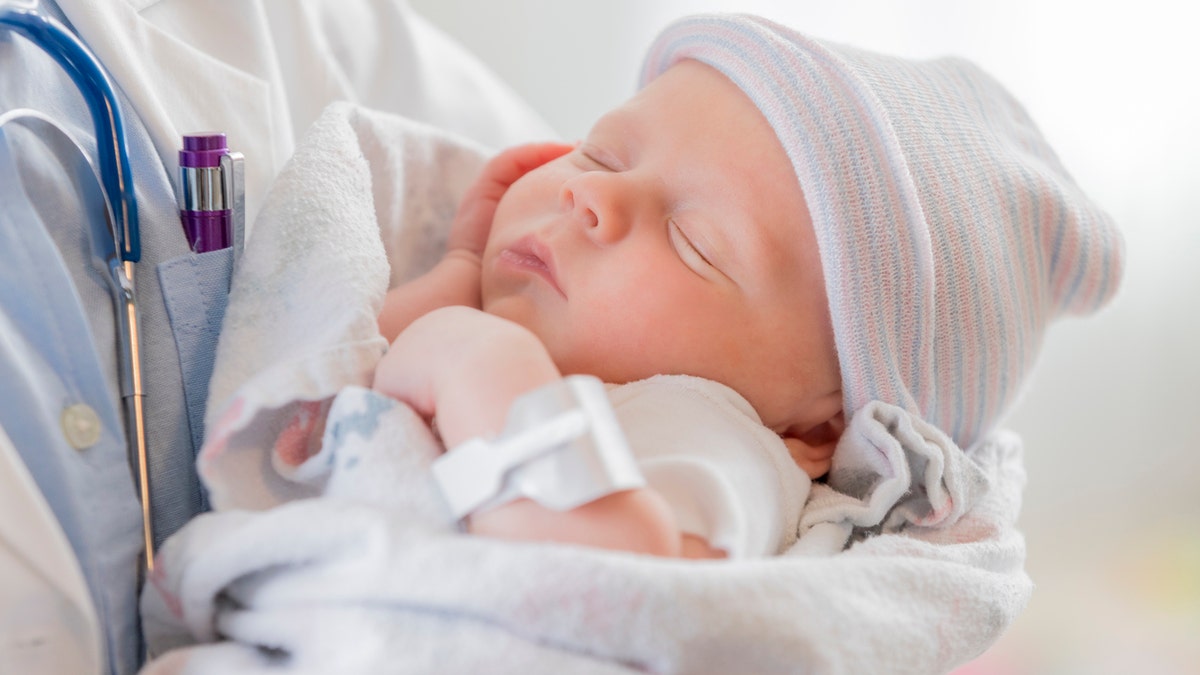
A Caucasian female infant is asleep in the arms of a pediatrician. The baby is swaddled in a blanket and is wearing a warm cap. (iStock)
It’s a terrible fear among new parents: you put your healthy baby down to sleep, but your baby never wakes. Unfortunately, that nightmare is a reality for too many families across the U.S.
Each year, we lose an estimated 3,500 babies nationwide to sleep-related deaths such as sudden infant death syndrome (SIDS) and accidental suffocation. Although mothers, fathers and other caregivers can take steps to reduce the risk, new research from the federal Centers for Disease Control and Prevention reveals that many are not following recommendations aimed at creating a safer sleep environment.
We know that one way to reduce sleep-related deaths among babies is to follow these guidelines from the American Academy of Pediatrics:
Babies should sleep in their own sleep space. Have the baby share your room, but not your bed. Your baby should not sleep in an adult bed, on a couch, or on a chair alone, with you, or with anyone else.
Always place babies on their backs to sleep. Do this for every nap, every night, every time.
Put babies to sleep in a safety-approved crib or bassinet with a firm sleep surface or mattress. Keep all soft objects, including pillows, loose blankets, bumpers and toys out of the baby’s sleep area.
Yet according to our latest Vital Signs report, one in five mothers reported placing their babies to sleep on their side or stomach; more than half said they shared a bed with their babies; and two in five reported using soft bedding in the babies’ sleep area.
As a doctor – and perhaps most important, as a mother – these findings concern me. It’s clear that we have work to do when it comes to protecting our babies.
We must do more to ensure every caregiver, health-care provider, and state and local health department is aware of these evidence-based recommendations. And we must do a better job at dispelling some of the common myths that prevent all babies from having a safe sleep environment.
For example, some new parents may still be following the lead of their own parents and grandparents. In times past, babies were more likely to be tucked into the parents’ beds, or put to sleep on their stomachs due to fears they could spit up and choke.
But we now know that babies are safer when they sleep on their backs. This is likely because of airway anatomy. When a baby is on its back, the windpipe – or airway – is on top of the food tube, or esophagus. When a baby is on its stomach, it is easier for the airway to be obstructed if the baby spits up or vomits.
We must also continue to raise awareness among populations with the highest rates of sleep-related deaths. Our report revealed that among those who didn’t follow safe sleep recommendations, there were differences based on race, ethnicity, age and education. Although our analysis showed no difference in safe sleep practices based on gestational age, we know that premature infants are at greater risk of SIDS or other sleep-related deaths.
A national study found that only 55 percent of mothers reported getting correct advice about safe sleep during pregnancy and baby-care visits. Doctors and health-care providers are an influential source of information and can play a key role in awareness efforts.
Some states have made concerted efforts to improve safe sleep practices. In my home state of Georgia, a number of agencies and organizations have joined forces to reduce infant mortality and promote safe sleep practices.
Every delivery hospital in Georgia now offers lifesaving education, resources, and tools – including giving every new parent a safe-sleep book and an infant onesie with “this side up” messaging on the front and “please turn me over” on the back, to reinforce the importance of placing babies on their backs.
In Tennessee, the proportion of infants found in unsafe sleep situations was reduced by almost 50 percent following the implementation of a statewide hospital policy. Every birth hospital in the state of Tennessee was engaged in prevention efforts, including creating safe-sleep policies. That has paved the way for an ongoing collaboration to address challenges in adherence to safe-sleep recommendations.
A statewide public health campaign, such as giving information to every new parent, can make a real difference in promoting safe sleep.
Although we’ve made tremendous strides in saving babies from sleep-related deaths, that decline has slowed in recent years. We can and must do better to ensure they have a healthy future.
